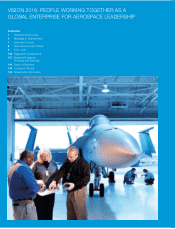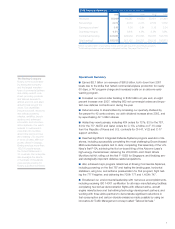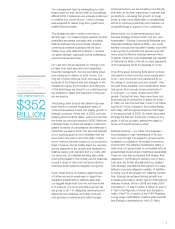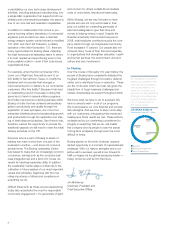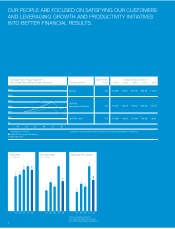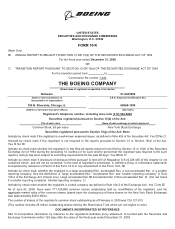Boeing 2008 Annual Report Download - page 7
Download and view the complete annual report
Please find page 7 of the 2008 Boeing annual report below. You can navigate through the pages in the report by either clicking on the pages listed below, or by using the keyword search tool below to find specific information within the annual report.
5
potential for increased pension-funding obliga-
tions unless markets rebound significantly —
making it all the more important that we com -
pensate by accelerating gains in productivity and
aggressively seeking other ways to generate or
conserve cash in every part of our business.
Another new challenge revolves around the
renewed strength of the U.S. dollar, which
declined almost continuously against the Euro
and other currencies for six years. In the dollar-
denominated world of commercial airplane and
military aircraft sales, a weak dollar worked to our
advantage — and it put Airbus and other over-
seas competitors under ever-increasing pressure
to attack costs, drive productivity and increase
their competitiveness. And so they have.
Now the pressure is on us. With a resurgent dol-
lar, the situation has reversed itself. That is why
we are taking bold measures to reassert our own
competitiveness.
We are being ever more aggressive in managing
both costs and investments. We have reduced
our discretionary and capital-spending budgets.
We have realigned our organizational structures
to both streamline and strengthen them. We are
eliminating what, in today’s world, constitutes
unnecessary work, and we are reducing staffing
levels to support a trimmed-down infrastructure.
At the same time, we have tightened the integra-
tion of our businesses and of the corporate func-
tions that support them.
These steps are not easy, especially where they
impact employment of our people, but they are
necessary to preserve our financial strength in
the midst of economic uncertainty, to continue
investing in growth projects and to fund our com-
mitments to our employees and our shareholders.
Energy and the Environment
Energy and concern for the environment continue
to be huge factors in our business — and that of
our customers, as well.
Regardless of the recent fall in oil prices, there is
broad agreement that the long-term trend line in
fossil fuel prices is upward and that resumed
world economic growth will stimulate demand
and cause oil prices to rise again. At the same
time, there is a growing movement on the part of
governments to use tax policies and regulatory
powers to reduce emissions of greenhouse gases,
caused by the burning of fossil fuels, including
the roughly two percent of world carbon-dioxide
emissions attributable to commercial aviation.
The most obvious ways to limit emissions — and
to contain high and volatile fuel prices — is to
use fuel more efficiently. The search for more fuel-
efficient airplanes is a never-ending part of Boeing’s
business. Over the past 50 years, fuel-efficiency
improvements have reduced carbon-dioxide
emissions by Boeing airliners by about 70 percent,
while also limiting noise emissions — another
important environmental factor — by 90 percent.
Boeing is committed to improving the fuel effi-
ciency of each new generation of commercial
airplane by 15 percent, in order to attain the
International Air Transport Association’s goal of a
25 percent overall improvement in fuel efficiency
by 2020.
Working with other firms, Boeing has extensively
researched and tested the development of
advanced-generation biofuels, which could pro-
vide a truly sustainable substitute for today’s jet
fuel — ”sustainable” meaning new fuels that do
not adversely impact world food or water sup-
plies or impede valuable land use. With airline
partners, we have conducted demonstration
flights on Boeing airplanes with jet fuel made
from various sustainable biomass sources, all
of which — unlike fossil fuels — consume carbon
dioxide as they grow, helping commercial avia -
tion achieve its target to reduce carbon-dioxide
emissions on a life cycle basis. Tests show
these sources can be blended with one another
and with fossil-based fuel, thereby enhancing
market readiness.
We also are committed to act as a good steward
for the environment in our facilities. During 2008,
we met our goal of achieving the ISO 14001
environmental management system standard at
all of our major manufacturing sites, and we con-
tinued to make good progress in meeting other
long-term environmental performance targets by
improving energy efficiency, enhancing recycling
rates and reducing waste.
Leveraging Our Strengths
Many of our successes in international competi-
tions have been due in part to our two core busi-
nesses increasingly acting as one. As appropriate
in countries around the world, people from the
two businesses work closely together on com-
mon strategies.
But it is not only in individual countries that we
benefit from our integrated approach; it is almost
everywhere within Boeing. Across the enterprise,
we are slimming and streamlining our organiza-
tion, and we are centralizing and consolidating
more and more activities. For example, we are
The market value for
commercial aviation is
expected to grow to
$3.2 trillion over the next
20 years, providing long-
term growth opportunities
for Boeing Commercial
Airplanes.
MARKET VALUE BY REGION
2008–2027
8%
4%
2%
Asia-Pacific 1,190
North America 740
Europe and CIS* 810
Middle East 260
Latin America 140
Africa 60
23%
38%
25%
Total Market Value $3.2T
Region $B
* Commonwealth of
Independent States


